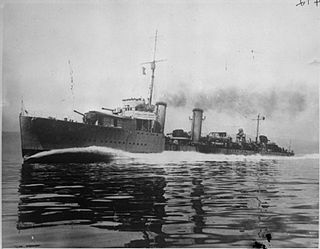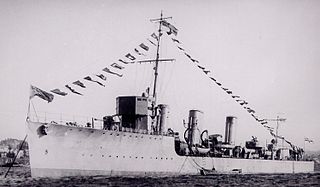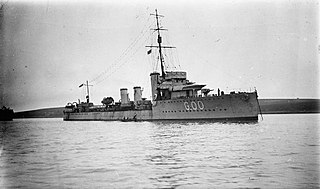
HMS Broke was a Thornycroft type flotilla leader of the Royal Navy. She was the second of four ships of this class that were ordered from J I Thornycroft in April 1918, and was originally named Rooke after Rear Admiral Sir George Rooke of the Dutch Wars and the Battle of Vigo Bay.

HMS Seafire was an S-class destroyer built for the Royal Navy during the First World War. She saw service during the Allied intervention in the Russian Civil War. The ship was sold for scrap in 1936.

HMS Valkyrie was a First World War V-class flotilla leader of the Royal Navy. She was one of two destroyers ordered in July 1916 from William Denny & Bros. Ltd shipyard under the 9th Order for Destroyers of the Emergency War Program of 1916–17. She was originally to be called HMS Malcolm but was renamed before being completed. The name Malcolm was later assigned to another destroyer leader.

HMS Valentine was a V and W-class destroyer, built in 1917 for the Royal Navy. She fought in both world wars, serving in several capacities. She was heavily damaged by air attack and beached in 1940 near Terneuzen. Her hulk remained there until it was broken up in 1953.

The fifth HMS Valorous, ex-HMS Montrose, was a V-class flotilla leader of the British Royal Navy that saw service in World War I, the Russian Civil War, and World War II.

HMS Bruce was the second of eight Admiralty type flotilla leaders of the Royal Navy. Built by Cammell Laird, Bruce was commissioned on 29 May 1918. During the First World War, she served with the 10th Destroyer Flotilla at Harwich. After the end of the war, Bruce spent several years in reserve at British ports, before spending almost 10 years based on the China Station. She was withdrawn from use because of her poor condition, and was sunk as a target ship on 22 November 1939.

HMS Mackay was an Admiralty type, sometimes known as the Scott class, flotilla leader of the British Royal Navy. Mackay was built by Cammell Laird during the First World War, but was completed too late for service then, commissioning in 1919.

HMS Campbell was an Admiralty type flotilla leader of the British Royal Navy. Built by Cammell Laird, Douglas commissioned in December 1918, just after the end of the First World War. During the Second World War, Campbell mainly served with as a convoy escort, particularly on the East Coast of the United Kingdom. She survived the war, and was sold for scrap in 1947.

HMS Tirade was a Modified Admiralty R-class destroyer which served with the Royal Navy during World War I. The Modified R class added attributes of the Yarrow Later M class to improve the capability of the ships to operate in bad weather. Launched in April 1917 by Scotts Shipbuilding and Engineering Company, the vessel served with the Grand Fleet. The vessel was involved in escorting convoys in the Irish Sea and North Sea. During one of these duties, in September 1917, Tirade sank the minelaying submarine UC-55. During the following month, the destroyer accidentally struck and sank the M-class destroyer Marmion. After the war the destroyer was placed in reserve and then, in November 1921, was sold to be broken up.

HMS Rapid was a destroyer of the M class that served with the Royal Navy during First World War. Launched by Thornycroft in 1916, the vessel was the one of two similar ships ordered as part of the Fifth War Construction Programme. They differed from the remainder of the M class in having more powerful engines. The design was used as the basis for the subsequent five ships of the R-class also built by the yard. Rapid served in escort and patrol roles, principally providing defence from submarines as part of the Grand Fleet until it was disbanded at the end of the War. After the end of hostilities, the vessel served in minor roles, including briefly as part of the Admiralty Compass Department in 1921 and 1924, but was sold to be scrapped in 1927.
HMS Gabriel was a Marksman-class flotilla leader of the British Royal Navy, that took part in the First World War. The ship was built by Cammell Laird at Birkenhead, being launched on 23 December 1915 and entering service in July 1916. Gabriel served with the Grand Fleet, leading a destroyer flotilla and was later used as a minelayer. She survived the war, before being sold for scrap on in May 1921.
HMS Grenville was a Parker-class flotilla leader of the British Royal Navy. She was built by Cammell Laird during the First World War, being launched on 17 June 1916 and completing on 11 October that year. Grenville served with the Grand Fleet for the rest of the war, which she survived. The ship took part in operations in the Baltic during the Russian Civil War in the winter of 1919–1920, before entering a long period of reserve. She was sold for scrap in December 1931.

HMS Seymour was a Parker-class flotilla leader of the British Royal Navy. She was built by Cammell Laird during the First World War, being launched on 31 August 1916 and completing on 30 November that year. Seymour served with the Grand Fleet for the rest of the war, which she survived. The ship was sold for scrap in January 1931.
HMS Saumarez was a Parker-class flotilla leader of the British Royal Navy. She was built by Cammell Laird during the First World War, being launched on 14 October 1916 and completing on 21 December that year. Saumarez served with the Grand Fleet for the rest of the war, which she survived. The ship was sold for scrap in January 1931.
HMS Spenser was a Thornycroft type flotilla leader of the British Royal Navy. She was built by J I Thornycroft from 1916 to 1917 as the lead ship of her class, launching in September 1917 and completing in December that year.

HMS Wallace was a Thornycroft type flotilla leader of the British Royal Navy. Built by J I Thornycroft during the First World War, Wallace was launched on 26 October 1918, and completed in February 1919, after the end of the war.

HMS Sepoy was an S-class destroyer, which served with the Royal Navy during the First World War and the Russian Civil War. Sepoy was launched in 1918 and initially joined the Grand Fleet. After the Armistice that ended the First World War, the ship was briefly transferred to the Reserve Fleet before sailing to Tallinn in 1919 as part of the Royal Navy response to the fighting there. Sepoy rejoined the Reserve Fleet at the end of the year. In 1922, the destroyer served in the Mediterranean Sea. The ship was later allocated to the naval base in Hong Kong, arriving in 1929. During exercises the following year, a depth charge explosion killed six sailors. The destroyer was also damaged. Following the signing of the London Naval Treaty a few days later, Sepoy returned to the United Kingdom and, in 1932, was sold to be broken up at Newport, Wales.

HMS Napier was a Repeat Admiralty M-class destroyer which served in the Royal Navy during the First World War. The M class were an improvement on the previous L-class destroyer, capable of higher speed. The vessel was launched on 27 November 1915 and joined the Grand Fleet. Napier had a varied war career, acting as part of the destroyer screen for the First Battle Squadron during the Second Battle of Heligoland Bight and searching for the survivors of losses like the armoured cruiser HMS Hampshire. The vessel was usually based at Scapa Flow but spent a brief time seconded to the Harwich Force in 1917. After the Armistice that marked the end of the First World War, Napier was placed in reserve before being decommissioned and sold to be broken up on 8 November 1921.

HMS Scotsman was an S-class destroyer that served with the Royal Navy during the Russian Civil War. The S class was a development of the previous R class, with minor differences, constructed at the end of the First World War. Scotsman was completed in May 1918 and joined the Grand Fleet for the last few months of the War. The destroyer then joined the British campaign in the Baltic, sailing as part of a detachment of ten destroyers under the command of Admiral Walter Cowan in March 1919. Scotsman provided military and humanitarian assistance to the Latvian cities of Liepāja and Ventspils in April 1919. On returning to the UK, the ship was placed in reserve, initially at Rosyth and later Devonport. The destroyer remained in reserve until, in July 1937, Scotsman was sold in part-exchange for the liner Majestic and broken up.

HMS Seabear was an S-class destroyer that served with the Royal Navy during the Russian Civil War. The S class was a development of the previous R class, with minor differences, constructed at the end of the First World War. Seabear was launched in December 1917 and joined the Grand Fleet for the last few months of the War. The destroyer then joined the British campaign in the Baltic, sailing as part of a detachment of ten destroyers under the command of Admiral Walter Cowan in March 1919. Seabear sailed to Tallinn in support of the Estonian War of Independence the following month. On returning to the UK, the ship was placed in reserve. The London Naval Treaty limited to number of destroyers that the Royal Navy could operate and, as new ships entered service, older vessels were retired. Seabear was sold in February 1931 and broken up.















